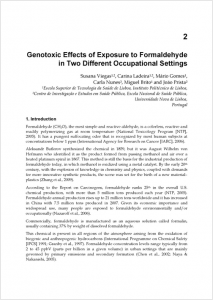 Para além do ensino e dos serviços à comunidade, a investigação é outro dos pilares da missão da Escola Superior de Tecnologia da Saúde de Lisboa (ESTeSL), à qual a área científica de Saúde Ambiental não se tem mantido indiferente. Prova disso é publicação do livro Carcinogen, editado por Margarita Pesheva, Martin Dimitrov e Teodora Stefkova Stoycheva, e que se encontra entretanto disponível online.
Para além do ensino e dos serviços à comunidade, a investigação é outro dos pilares da missão da Escola Superior de Tecnologia da Saúde de Lisboa (ESTeSL), à qual a área científica de Saúde Ambiental não se tem mantido indiferente. Prova disso é publicação do livro Carcinogen, editado por Margarita Pesheva, Martin Dimitrov e Teodora Stefkova Stoycheva, e que se encontra entretanto disponível online.
A relevância da notícia é o capítulo Genotoxic Effects of Exposure to Formaldehyde in Two Different Occupational Settings, que conta com a colaboração de quatro docentes da ESTeSL e dois da Escola Nacional de Saúde Pública da Universidade Nova de Lisboa.
A esta informação acresce o facto da primeira autora ser Susana Viegas, docente da área científica de Saúde Ambiental da ESTeSL.
Aqui fica a referência…
Susana Viegas, Carina Ladeira, Mário Gomes, Carla Nunes, Miguel Brito and João Prista (1970). Genotoxic Effects of Exposure to Formaldehyde in Two Different Occupational Settings, Carcinogen, Margarita Pesheva, Martin Dimitrov and Teodora Stefkova Stoycheva (Ed.), ISBN: 978-953-51-0658-6, InTech, Available from: http://www.intechopen.com/books/carcinogen/genotoxic-effects-of-occupational-exposure-to-formaldehyde
Formaldehyde (CH2O), the most simple and reactive aldehyde, is a colorless, reactive and readily polymerizing gas at room temperature (National Toxicology Program [NTP], 2005). It has a pungent suffocating odor that is recognized by most human subjects at concentrations below 1 ppm (International Agency for Research on Cancer [IARC], 2006).
Aleksandr Butlerov synthesized the chemical in 1859, but it was August Wilhelm von Hofmann who identified it as the product formed from passing methanol and air over a heated platinum spiral in 1867. This method is still the basis for the industrial production of formaldehyde today, in which methanol is oxidized using a metal catalyst. By the early 20th century, with the explosion of knowledge in chemistry and physics, coupled with demands for more innovative synthetic products, the scene was set for the birth of a new material– plastics (Zhang et al., 2009).



